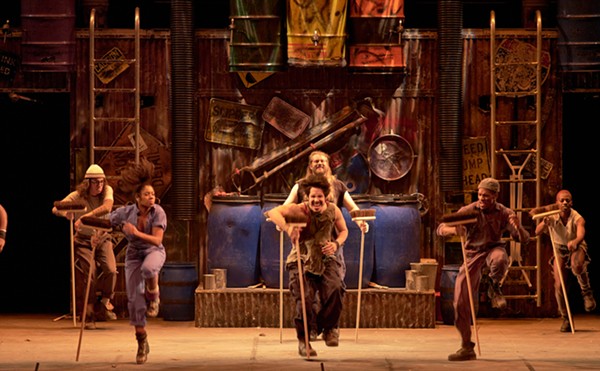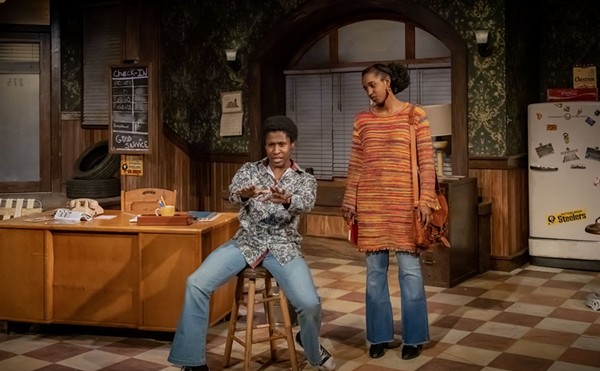Christopher Duffy: Do I Know You? -- There's a giant electric contraption slowly spinning fragments of mirror in a jar, like ice cubes in a glass; images created using sheets of paper as oversized cigarette filters; a messy but inert machine that sucks up paint and turns it into piles of red, yellow, and orange spaghetti -- these are the brilliant, Seussian fruits of Christopher Duffy's imagination. How seriously to take them is up to you; this writer, for one, can't see anything profound in them. A Chicago native who has lived and worked in Cleveland for years, Duffy has a long-standing interest in dynamic glass and mixed-media sculpture, and these must represent his most elaborate creations to date. A tiny white-glass ghost with golden eyes occupies a tiny house atop a glassy green hill in "Exorcism by Oxidation" (so titled because oxidation, in theory, would render the ghost invisible). Though most of Duffy's work is playful and more or less about sensory effects, some of his fantasies are bound to leave you scratching your head. His aesthetic rationale may be shaky at times, but his technical abilities are unquestionable. Through December 4 at the Sculpture Center, 1834 E. 123rd St., 216-229-6527, www.sculpturecenter.org. -- Zachary Lewis
Dreaming of a More Better Future -- The woman screaming on this exhibit's poster pretty much sums it up. The scenarios presented across this large, variably worthwhile display range from disturbing to chilling -- "something horribly remote and distinct from mankind," to quote Nick Rule's inky text painting at the entrance. It's too bad that Jose Krapp's well-stocked fallout shelter, called "Are We There Yet," is considered a work of art, or that Nicola Lopez's print "On the Horizon," featuring a hillside landscape densely packed with cellular towers and satellite dishes, glimpses our future reality. One work cuts extremely close to home: In Ted Savinor's "News From Tomorrow" headlines, terrorists have destroyed Disneyland and Browns Stadium. Not every prediction is terrifying; some are just depressing: "Ghost of Progress," Paul Ramirez's video of a model jet racing through a poor Mexican town underscores how wide the global economic gap is growing. There are also moments of hope: Architectural designs by Acconci Studio predict elegant, organic forms, and eclectic public protests organized by Miranda July and Harrell Fletcher suggest that at least some people are willing to take action for change. Through December 22 at the Cleveland Institute of Art, 11141 East Blvd., 216-421-7407, www.cia.edu. -- Lewis
Reduced to a Faulty Recollection -- It seems that painter Jeffrey Cortland Jones is at cross-purposes with himself. He successfully delights viewers with textural diversity and abstract techniques, then complicates things with an apparently biographical subtext only he can fully appreciate. He avows an interest in "damaging" and "repairing" art objects until only a "residual" version of the original remains. Whatever exactly that means, his paintings here are visually delicious, and they do seem to have been beaten up a bit. Jones employs a variety of media -- enamel, resin, acrylic, plaster -- applying them layer-by-layer in straight-edged sections within fiberboard squares. Surfaces range from smooth and marblelike to rough and jagged. Painterly gestures -- vigorous, dense hatch marks and smoke stains, usually -- are often visible beneath solid-colored topcoats. In one of his more elegant, loosely executed images, light-green waves lap calmly on an abstract beach. It's easy to imagine the emotions that inspired these pictures, but Jones doesn't trust us. Instead, he burdens his work with wordy, interchangeable titles that offer zero insight. "Between the End and Where We Live Are Words: Guilty of Deceit" is a prime example. A vaguely discernible narrative documenting a failed romance unites the exhibit. By the end, Jones is painting "A Healthy Distrust Hidden Behind Security" and "To Prove That I Can Survive Without You." Now he just needs to make one more break, between art and life. Through December 3 at E. Gordon Gallery, 2026 Murray Hill Rd., 216-795-0971, www.egordongallery.com. -- Lewis
ONGOING
Design for the Modern World: The Arts and Crafts Movement in Europe and America, 1880-1920 -- The art museum's first major arts-and-crafts show in years is notable not only for its enormous size, but for the many far-flung cultures (included are works from Germany, Scandinavia, Scotland, and Hungary) that share space. But what really unites these rooms of exquisitely designed teapots, tables, chairs, lamps, jewelry, and vases is the notion that arts and crafts are anything but stylistically homogeneous: Resisting the push toward industrialism, crafts practitioners cared about design that was beautiful but functional and, above all, honest in construction. Paramount was evidence of their origin -- visible screwheads on a chair or tiny hammer marks on a silver teapot; objects with such traits, even if they were mass-produced, were deemed inherently better. Some artists, like Henry Van de Velde, who designed an entire modernist dining room for a department store, also valued affordability. The movement was a lifestyle, too, with small communes forming around these principles. The exhibit culminates in America with some elegant chairs and lamps obviously designed by Frank Lloyd Wright. There's even a nod to Cleveland's golden age of enamel. In short, Design for the Modern World renders a potentially dull subject in the most compelling manner possible. Through January 8 at the Cleveland Museum of Art, 11150 East Blvd., 216-421-7340, www.clevelandart.org. -- Lewis
Drawn to Cleveland -- More than a tribute to a generous museum patron or to the city, this group exhibition feels like a reunion. Fourteen nationally recognized artists are represented here through various works on paper. Each is connected to Cleveland, and many have shown at MOCA previously, but beyond that common experience, they've followed widely different paths. Robert Crumb's anxiety-ridden cartoons are perhaps the most famous; the best of the five examples here is his most recent, a French-themed set about consumerism called "Creeping Global Villagism," from 2004. Dana Schutz is present through three captivating black-and-white portraits of friends, whom she conveys with brutal, vaguely cubist honesty; even her self-portrait, a figure with a jack-o'-lanternlike head, is unsparing. April Gornick and Heide Fasnacht, meanwhile, wield graphite and charcoal with stunning virtuosity. Gornick's "Allee" may be the most memorable piece in the show: Using charcoal, she captures the play of light moving between groves of neatly planted trees, the horizon receding almost infinitely. Fasnacht's "Big Bang," a picture of an explosion, is pencil drawing at its most technically accomplished, but her "Sneeze V" is truly inspired: An icky mess spews across the immense page in the form of tiny, singed punctures to the paper. Through December 30 at the Museum of Contemporary Art Cleveland, 8501 Carnegie Ave., 216-421-8671, www.mocacleveland.org. -- Lewis
POPulence -- Splendor and extravagance are the defining traits of this large-scale group exhibition organized by the University of Houston Art Museum. From velvet DayGlo flowers on the floor to swooning visions in latex and acrylic on the walls, POPulence proves without question that pop art has moved into a brighter and more expansive new realm. It's tough to say who's furthest over the top, but L.C. Armstrong probably takes that honor. Her immense Hawaiian seascapes, complete with figures frolicking in the water, are almost ridiculously naive. Were it not for the frighteningly large flowers in the foreground, they might be perfect for travel brochures. Next in line is Chiho Aoshima, with her panoramic reveries about youthful aimlessness; her cute, anime-style figures drift like Japanese versions of Ophelia through scarily enchanted undersea environments fashioned out of film negatives and Plexiglas. Lacking any such narrative intent, David Reed takes graffiti art to a new level. He uses alkyd paints to create dynamic swirling lines so nearly three-dimensional, they're like liquids in motion. Kim Squaglia's colorful, multilayered combinations of latex, resin, and oil resemble Starburst chews and look good enough to eat. Then again, so do many pieces in this gloriously hedonistic exhibition. Glossy, sensuous, and full of references to contemporary culture, the whole show is candy for the eyes. Through December 30 at the Museum of Contemporary Art Cleveland, 8501 Carnegie Ave., 216-421-8671, www,mocacleveland.org. -- Lewis
Sculpture Garden -- The small sculpture garden at Atmosphere's new Tremont digs is filled with engaging sights. Alex Stoll's burnt-steel dragonflies and squirrels hover over shrubbery like busy real-life creatures. A large insect with brightly colored metal bars for legs oversees the garden's back half. Near the front, Lothar Jobczyk's "Garden Spirits" -- sandstone blocks with craggy, totemic faces -- poke their heads above the plants; commendably, Jobczyk managed to give each one a personality without squandering their dense, stony qualities. But the sculptures by Frank Brozman and Jerry Schmidt are the kings of this jungle. Brozman's are abstract realizations in brown steel of familiar materials and physical processes. Ornate flower planters are among his more obvious examples, but he can be subtler: At first, his "Insatiable" looks like nothing more than a large flat piece of steel connected to its stand by a metal coil. Viewed from the side, however, it becomes a face and stomach forever trapped in a cycle of feeding and regurgitating. Schmidt's "Photogenic" compares in size to the giant insect, but surpasses it conceptually: A circle of blue steel punctures a large, flesh-colored plate, like a lens coming out of a camera. Not only does it evoke photography in this way; the whole, curvaceous, semi-animate thing appears to be posing for a picture. Atmosphere Gallery, 2379 Professor Ave., Suite 1, 216-685-9527. -- Lewis












